Will CLR Remove Rust From Concrete? (The Dos & Dont’s)
-
Pete Ortiz
- Last updated:

Rust stains can be frustrating to remove from surfaces and concrete is no exception. But what can you use? Consider using CLR to tackle those rust stains. CLR will remove rust from concrete, but there are some provisions to consider. To ensure that you safely and effectively remove rust from concrete, we’re sharing some tips and considerations for using CLR.
So before you start, it’s important to understand how CLR works and what steps you need to take for optimal results. With a planned approach, you can look forward to rust-free concrete that looks great and stands the test of time.
 What Does CLR Do?
What Does CLR Do?
As its name implies, CLR (Calcium Lime Rust) Remover is a commercial product designed specifically to remove calcium, lime, and rust from various surfaces. It is a strong acid that quickly penetrates and breaks down the rust, allowing it to be easily wiped away.
However, it is also important to note that this acid can cause damage if not used properly. This is where it’s crucial to understand when to use CLR and when to use something else.
What Is the Best Rust Remover for Concrete?
Rust is a common problem for concrete surfaces inside and outside the home. Not only does the presence of rust detract from the appearance of the surface it’s on, but it also makes it difficult to clean.
That’s why so many homeowners turn to CLR as the best solution for removing rust from concrete surfaces. CLR is a powerful cleaner that can remove rust from concrete and other surfaces.
However, it is important to use CLR properly to get the best results and ensure safety, as CLR can potentially damage your concrete if you’re not careful.
The Dos and Don’ts of CLR on Concrete
In most cases, you can safely use CLR on concrete. But there are a few things you need to keep in mind before attempting to use CLR on your concrete surfaces.
- First, never use CLR on concrete that’s less than a year old after being poured. Concrete needs to cure for at least one year before it can be safely treated with CLR.
- Second, CLR isn’t safe to use any specially treated concrete. So if your concrete is colored, sealed, stamped, coated, or otherwise treated in any way, you should avoid using CLR on it
- Once you’ve established that your concrete is more than a year old and isn’t treated, test the CLR on a small, inconspicuous area before using it on the entire surface. This will help you determine if the CLR is safe to use on your concrete
- If the cleaner produces the results you want on the small test area, you can safely proceed with using it on the entire surface. Make sure to use a protective barrier, such as goggles and gloves, when applying CLR to your concrete.

 Conclusion
Conclusion
CLR has a long history of being a reliable rust remover for concrete. But as with any cleaner, it’s important to use it safely and properly in order to ensure that you get the best results and avoid potential damage.
By understanding what CLR is, when to use it, and how to use it safely, you can look forward to a beautifully rust-free concrete surface that looks great for years to come.
Featured Image By: Gregory Alan Eagle, Shutterstock
Contents

 What Does CLR Do?
What Does CLR Do?
